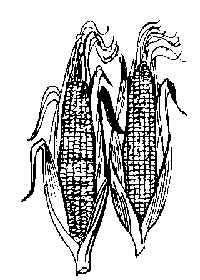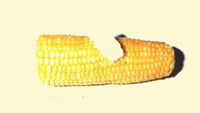Sweetcorn
 A lot of people say that 'corn on the cob' is tough and tasteless but this is because they have probably never had it fresh from the plant. Once Sweetcorn is picked the sugars in it start to convert to starch and the kernels start to dry out and become tough. To have Sweetcorn at its best, you have to pick the cobs and cook them within 1 hour. Also a lot of people think that it cannot be grown as it is a semi tropical plant and that it needs high temperatures to grow. This was true of most of the older varieties but new varieties are a lot more tolerant and will grow in most areas. There are two types, the ordinary and the extra sweet. The extra sweet varieties must be grown on their own as any cross pollination with another variety will reduce the sugar content.
A lot of people say that 'corn on the cob' is tough and tasteless but this is because they have probably never had it fresh from the plant. Once Sweetcorn is picked the sugars in it start to convert to starch and the kernels start to dry out and become tough. To have Sweetcorn at its best, you have to pick the cobs and cook them within 1 hour. Also a lot of people think that it cannot be grown as it is a semi tropical plant and that it needs high temperatures to grow. This was true of most of the older varieties but new varieties are a lot more tolerant and will grow in most areas. There are two types, the ordinary and the extra sweet. The extra sweet varieties must be grown on their own as any cross pollination with another variety will reduce the sugar content.
Sweetcorn are extremely greedy plants and need as much nutrition as possible. They therefore need a soil with as much organic matter as possible in it and a pH of about 6.5.
Start the seed off in mid April. The best way to do this is to sow the seed in individual peat pots or in 3" cell trays. Most books recommend that you sow 2 seeds in each pot or cell and then thin to the strongest seedling. Personally I have always found this to be a very wasteful method. Why buy 2 packets of seed just to throw one packet away?
From experience I have found that you usually get about a 95% germination rate from the seed.
What I prefer to do is to lay the seed out on a couple of layers of damp kitchen roll in a seed tray, covered by 2 more layers of damp kitchen roll. I personally use a cheap heated propagator to speed the germination process up. In the heated propagator they germinate within 24 hours. If you do not have a propagator just use an ordinary seed tray and keep it in a warm place. As soon as the seed has germinated, transplant it into peat pots, 3" pots, or, as I do, into 3" cell trays. Half fill the pot or cell with potting compost, place the seed in, making sure that you do not damage the little tail that has grown as this is the main root of the plant, and top up with compost. Water well and put in a warm place to continue growing. Ensure that the pots or cells do not dry out but also make sure that they are not over wet. They will be ready for planting out in mid May when all danger of frost is past.
A week before you are due to plant out it is worthwhile to harden the plants off by placing outdoors each day and bringing them in at night. If you have a coldframe this s an ideal place to put them. It can be left open during the day and closed off at night.
When planting out, all the books say that they should be planted in blocks spaced 2' apart in each direction. This is because the plants are wind pollinated and by planting in blocks there is more chance of each cob being pollinated better. This is all right if you have an open plan vegetable site but, if like me you use a bed system, it is impossible to plant in blocks. I therefore plant 18" apart and just fill the bed. I have grown Sweetcorn like this for the last ten years with no problems.
The seed can also be sown directly outdoors in May where it is to be grown.
Keep the plants well watered throughout the summer and weed free. I usually place all my grass clipping around the plants in a 3" - 4" thick layer, as a mulch. This helps retain the moisture and keeps down weeds.
When the tassels on the end of the cobs turn brown, check if the cobs are ready for picking by peeling back a bit of the leaf. Squeeze a couple of the kernels between you thumb and finger nails, a liquid will squirt out. If this liquid is clear, the cobs are not quite ripe. If it is a milky white then they are ready for picking. Break the cobs from the plant by twisting the cob downwards.

Now rush back to the kitchen, remove the leaves and cut off the stalk. Place the cob in a pan of boiling water; do not add salt or anything else. Boil for 3-4 minutes, no longer. Take the cob out of the water, smother in butter and enjoy Sweetcorn at its best.
As far as I know Sweetcorn do not suffer from any diseases. (See relevant Pests or Diseases sections)
© copyright 1999, P. A. Owen

